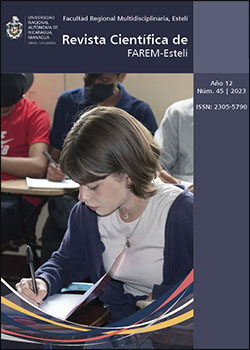Positive feedback for the teaching of conjugated, regular and irregular verb forms in 7th grade students, Rigoberto López Pérez Institute, Managua Nicaragua
DOI:
https://doi.org/10.5377/farem.v12i45.16038Keywords:
Strategy, regular verbs, irregular, feedback, educationAbstract
Feedback is used indirectly by teachers, especially in consolidation questions to verify the students’ understanding of the content or activities addressed during the subject of Language and Literature. From the sociocontructivist perspective, positive feedback can achieve better student learning. Likewise, it can be used as a strategy to improve the comprehension and assimilation of conjugated, regular and irregular verb forms in seventh grade students. It is essential that students internalize the conjugated forms in order to identify them and learn them in a practical and dynamic way, given that the uses of verbs do not maintain the same lexical base or morpheme as copulative verbs. The present research starts from the interpretative paradigm, with a qualitative approach, by means of applied and descriptive research it was possible to put into practice the novel strategy of positive feedback. The setting was the Rigoberto López Pérez School and the sample consisted of all seventh grade “A” students. The techniques used for data collection in the present study were the application of two instruments; the diagnostic test and a didactic sequence. The empirical, synthetic and analytical method was used to process the data. The main results obtained were: 7th grade students do not know in a conceptual and practical way the use of the verb and in the process of educational intervention there was little improvement in learning due to time interruptions in the planned activities, although some students showed mastery in the use of the copulative verb forms.
Downloads
References
Ayala, Maite. (19 de enero de 2021). Paradigma interpretativo. Lifeder. https://www.lifeder.com/paradigma-interpretativo-investigacion/
Bettini, Palacios M., y Rimoli K. (2009). La organización de Secuencias Didácticas en el Nivel Inicial. La provincia. Buenos aires,https://abc.gob.ar/secretarias/sites/default/files/2022-04/Organizaci%C3%B3n%20Secuencias%20Did%C3%A1cticas%20%282009%29.pdf
Cáceres Ramírez O. (2019). Los verbos irregulares en español, concepto y ejemplos.
Aboutespañol.https://www.aboutespanol.com/los-verbos-irregulares-en-espanol-2879644.
Cáceres Ramírez O. (2019) Las formas no personales del verbo: Infinitivo, Gerundio,
Participio. Aboutespañol. https://www.aboutespanol.com/las-formas-no-personales-del-verbo-2879642
Carranza, D. y Carranza, J. (2020). Importancia del uso de los marcadores discursivos para
mejorar la choesión en textos expositivos en estudiantes de noveno grado del instituto Rigoberto López Pérez. [Archivo PDF]. https://repositorio.unan.edu.ni/14540/1/14540.pdf
Díaz Barriga, A. (2013). Guía para la elaboración de una secuencia didáctica. UNAM- México. http://www.setse.org.mx/ReformaEducativa/Rumbo%20a%20la%20Primera%20Evaluaci%C3%B3n/Factores%20de%20Evaluaci%C3%B3n/Pr%C3%A1ctica%20Profesional/Gu%C3%ADa-secuencias-didacticas_Angel%20D%C3%ADaz.pdf
Gutiérrez Delgado J., Gómez Contreras F. J., y Gutiérrez Ríos C. (2018). Estrategias
didácticas de enseñanza y aprendizaje desde una perspectiva interactiva. Journal of Chemical Information and Modeling. https://www.conisen.mx/memorias2018/memorias/2/P845.pdf
Hovland I., R. (2020). Conjugación y uso de los tiempos básicos del español en verbos regulares: un análisis de errores. https://munin.uit.no/bitstream/handle/10037/19209/thesis.pdf?sequence=2&isAllowed=y
Liu J. (2020). Problemas del aprendizaje del verbo español en estudiantes chinos. los verbos irregulares y las formas no personales. Universidad de Salamanca, facultad de fiología, departamento de lengua española. https://redined.mecd.gob.es/xmlui/handle/11162/206252
Martín J. (2018). ¿Cómo dar un buen feedback (retroalimentación)? Cerem international business school. https://www.cerem.es/blog/como-dar-un-buen-feedback-retroalimentacion
Mendoza (2019). La planificación y sus componentes. Secuencia Didáctica. Recuperado de: https://ens9002-infd.mendoza.edu.ar/sitio/upload/planific._secuencia_didactica_1009.pdf
Monera V. (2020). Las nueve categorías gramaticales. Divinas palabras. https://www.victoriamonera.com/las-9-categorias-gramaticales/
Real Academia Española, (2010). Nueva Gramática de la lengua española, Manual. Espasa, Madrid. https://www.pdfdrive.com/manual-de-la-nueva-gram%C3%A1tica-de-la-lengua-espa%C3%B1ola-d186646104.html
Rodríguez, F. (2016). Características de las Secuencias Didácticas para liceos de Tiempo Completo, Tiempo Extendido y Propuesta 2016. http://liceoencasa.ces.edu.uy/images/pdf/_Recursos/Caractersticas_de_las_Secuencias_Didcticas.pdf
Rovira Salvador I. (2018). Estrategias didácticas: definición, características y aplicación. Psicología y mente. https://psicologiaymente.com/desarrollo/estrategias-didacticas
Sánchez Flores, F. A. (2019). Fundamentos epistémicos de la investigación cualitativa y cuantitativa: Consensos y disensos. Revista digital de investigación en docencia universitaria, 13 (1), 102-122. http://www.scielo.org.pe/scielo.php?pid=s2223-25162019000100008&script=sci_arttext
Torrez Fernández, C. (2020). Saca el máximo provecho al feedback en el aprendizaje.
Educación, Psicología y Sociedad. https://blogs.uoc.edu/epce/es/saca-maximo-provecho-feedback-aprendizaje-webinar-teresa-guasch-anna-espasa/
Published
Issue
Section
License
Copyright (c) 2023 Revista Científica de FAREM-Esteli

This work is licensed under a Creative Commons Attribution-NonCommercial-ShareAlike 4.0 International License.



